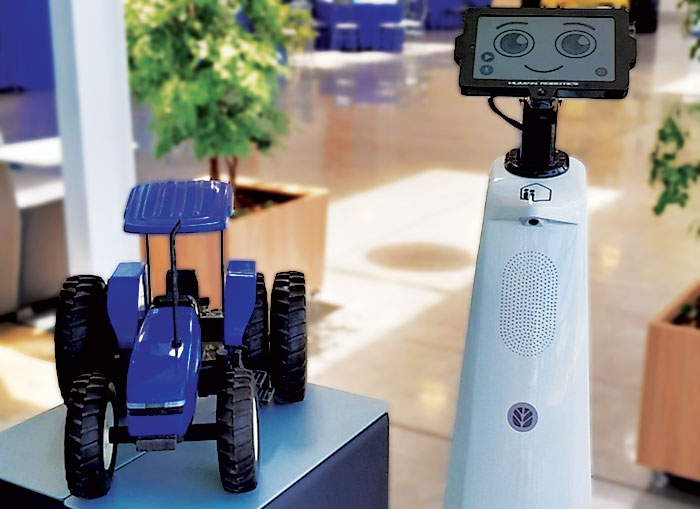
An Interactive Robot Points the Way to Smarter Farm Equipment
CNH engaged Agrishow 2025 visitors with a talking robot which answered questions and followed commands of voice prompts offering a glimpse into the future of machinery operation
Visitors to the CNH booth at this year’s Agrishow 2025, in São Paulo, Brazil, became part of a 2-way learning experience interacting with a robot using offline generative artificial intelligence (AI) — a tool that likely will soon be an integral part of the farm machinery business. The technology is named MAIA for Case IH and GUIA for New Holland.
Generative AI uses pre-programmed data models and neural networks to produce text, images, videos or other forms of data. Using programmed data to respond to input such as the human voice and natural language prompts, generative AI can use its “memory” to produce new data in the form of “answers” to verbal questions.
The CNH team used the technology to power a robot mingling with the Agrishow visitors at the company’s exhibit to engage with those who asked questions about the displayed farm machinery. Attendees could look at wiring diagrams and the robot could identify various circuits, such as lighting.
Visitors could then engage the robot with a voice command to “Turn on the lights” — and there was light. The robot was also capable of operating climate-control settings, cab lighting, etc.
Yara Carvalho, CNH chief information officer for Latin America, says the robot was an engaging way to introduce generative AI to the public, as well as providing feedback for a collaboration of various CNH professions such as product managers, information technology analysts, customer service representatives and those in precision agriculture.

CNH engaged Agrishow 2025 visitors with a talking robot which answered questions and followed commands of voice prompts offering a glimpse into the future of machinery operation. CNH Industrial
She says early proof-of-concept experiments with systems — using start-up generative AI and Alexa as an internal communication tool for CNH service representatives to query the factory about owner and service manual issues — led to a similar system (called MAYA in Latin America) by which end-users could also access in-depth factory service and operator information by using voice prompts. The company has similar systems in play in Europe and North America. A challenge with that system, however, is handling the bulk of information in owner and service manuals and interconnectivity issues.
“When we brought a similar system to Agrishow in 2024, even in the city of São Paulo, we had connectivity issues,” she explains. She says much of Brazil is quite remote and lacks dependable broadband internet service. This is a challenge to growers/operators on farms who need an efficient way to easily access manuals and diagrams relating to problems they may encounter. Enter offline generative AI.
With information stored in non-volatile digital memory it is conceivable much technical information could reside on equipment itself, and like the robot at the farm show, when necessary, growers could interact verbally or with their smartphones with the generative AI system on-board their farm equipment.
“These are possibilities we’re considering, and the interaction with the robot at Agrishow gave us much to consider as we think about how to help our customers solve problems more efficiently,” Carvalho explains. “The robotic exhibit was a proof-of-concept experiment for us, and an interesting personal experience for visitors to interact directly with AI.”
Carvalho also explained how the use of self-contained generative AI on-board farm equipment could alleviate some demand on centralized digital processing centers supporting the rapidly expanding use of all forms of AI.
“We’re looking at this as a sustainability issue also,” she says. If product-specific service and operating information could be part of the digital systems on farm equipment, that data could be quickly accessed in any environment regardless of connectivity. Also, such systems can be “trained” by on-board sensors to learn from the day-to-day use of the equipment to systematically improve its productivity through use.
Both advantages could be quietly at work daily — bypassing the need to add additional loads to the growing number of kilowatt-hungry digital processing centers which depend on the electrical grid and copious amounts of cooling water to operate.
A talking robot can be a powerful public relations tool at a farm show but don’t expect a digital humanoid sidekick as an accessory with farm equipment in the very near future. The “brains” of that Brazilian robot, however, represent a prototype of capability that likely will be stored alongside the firmware in the operating systems of your next tractor or harvester — regardless of color.
The technology is there and all of the majors will be innovating to take maximum advantage of the heavy lifting generative AI can provide — from on-board, on-the-go adjustments already in use on harvesters of many colors, to operator recommendations and “help desk” support on navigating volumes of service manuals. The machines are rapidly becoming “smarter.”

